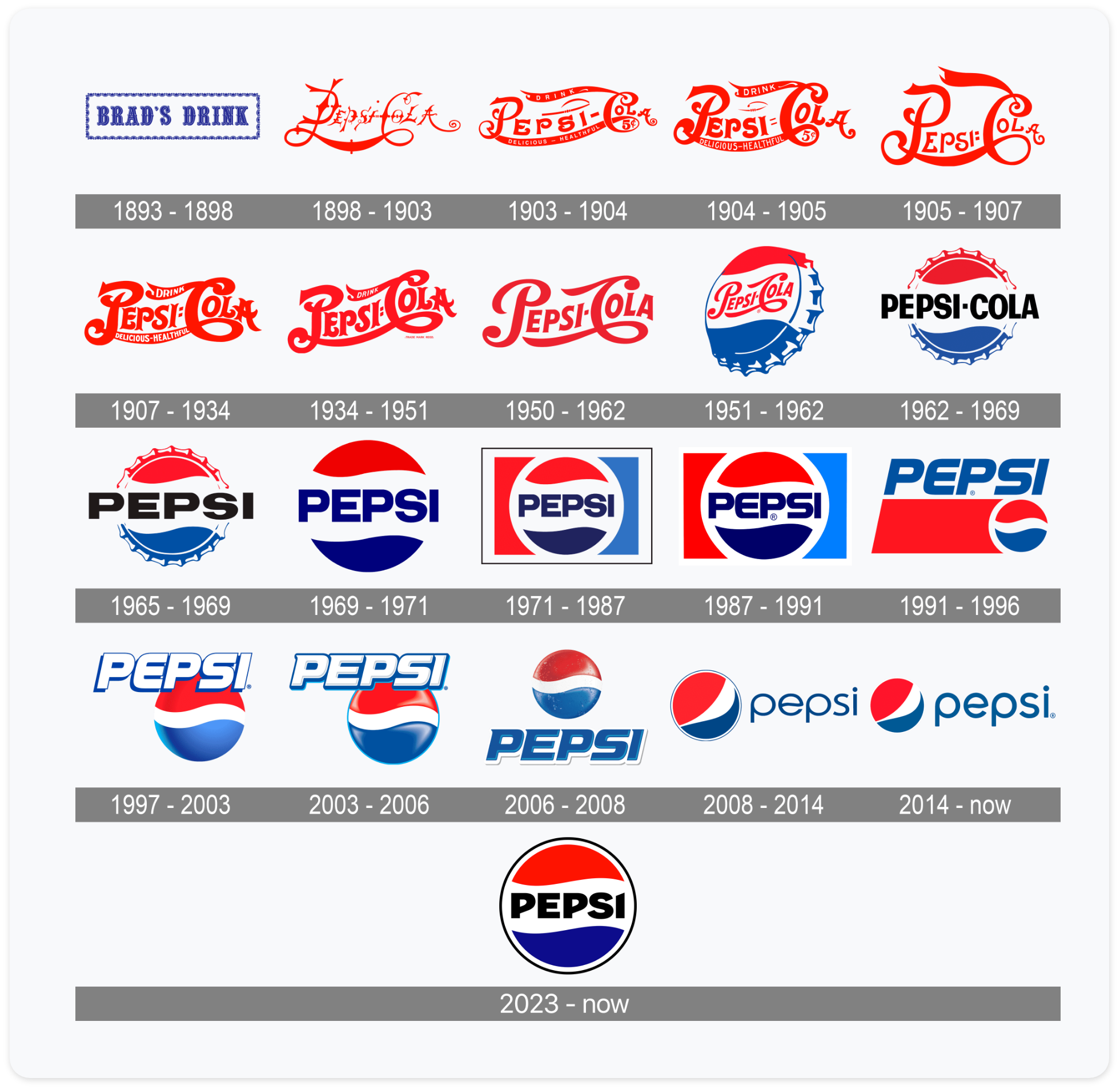What does the rebranding consist of?
Rebranding is the process by which the image of an already existing company or brand is changed. The scope of these changes sometimes varies – they may concern the color scheme used by the brand, fonts or the design of product packaging, but also more distinctive elements, such as the logotype and even the name. In the process of rebranding, brands often decide to change not only the visual elements, but also the mission, values or communication style.
The reasons and goals for rebranding can vary – often they have to do with the desire to refresh the image, change the profile of the business or the need to reach new target groups.
Where does the rebranding come from? The brand must respond to customer needs, and these can change significantly over the years. Often, however, behind the need or necessity for rebranding is an internal change, driven by the company’s desire to gain new customers or expand its operations.
Why rebranding?
It is from the question “why do I want to do a rebranding?” that one should start. There can be many answers, but it is especially important that one (or more) of them reveals to your brand the purpose of the rebranding. What could be the potential reasons to make sweeping changes?
Evolution of the company
Your business is changing. Perhaps it has significantly expanded its business, instead of sales it has also engaged in distribution, or perhaps it has completely changed its profile? History knows many cases in which a company started with a small slice, only to become bolder and bolder in the market over time.
With the evolution of the company also comes a change in expectations from customers. If an entrepreneur starts by setting up a pizzeria and, over time, decides to turn it into a restaurant, the target group he will target will also change. In such a situation, rebranding may be almost necessary, because – apart from the industry – almost everything changes: the menu, prices, services offered, as well as the decor of the premises or the way it communicates with guests.
More competition
The competition is not sleeping. More and more companies are being created that are trying to stand out in the crowd of others. If you want to climb to the top, or stay there, you need to watch for changes and keep abreast of the activities of other representatives of the sector in which you operate. Perhaps when your company took its first steps, there weren’t many competitors in the area or in the market at all. However, if you perceive that your brand is starting to slowly blend in with the crowd, it’s time to consider rebranding – just to clearly present what makes you stand out from the rest.
Image update
Rebranding doesn’t have to mean throwing everything you’ve used so far into the trash. Sometimes it’s just a matter of updating the image – bringing it up to current standards. For the past decade or so, a wave of simplification of identification elements – emblems, logos, color schemes – has been sweeping across various industries. Some companies have clearly “flattened” their emblems, simplified the fonts they use.
There are brands that have accustomed consumers to regular, more or less visible changes. A perfect example here is the Pepsi brand, which has changed its logo as many as 20 times in its 130 years of existence! Some of the changes were cosmetic, but many can boldly be considered radical.

Reaction to market volatility
The auto industry has been undergoing massive changes for several years. This is largely related to the development of electromobility, but also to the emphasis on environmental performance. New brands are emerging, new lines of hybrid vehicles, and many well-known manufacturers have decided to refresh (sometimes radically) their image. KIA, Peugeot, Dacia – these are just the first few examples off the top of my head. Each of these popular brands has recently unveiled new emblems, and with them a number of other changes.
There may be many reasons, but the transformation of the automotive industry is certainly one of the most important.
We can see a similar trend in the IT industry, which is due to the development of generative language models, or AI. Barring a massive bump in the artificial intelligence market, the next few years are sure to bring a number of key changes that will result in the rebranding of many brands already important in this area.
New strategy
There are also times when a company changes its strategy so much that its brand no longer resembles itself. In this case, a far-reaching rebranding often proves to be the only right solution.
Willingness to enter new markets
Polish companies that want to start operations in foreign markets often decide to create a new brand under which they start operating outside the country. However, if the company is at the threshold of change anyway, it may opt for a rebranding – one that allows for a new opening at home and a fresh start abroad.
There are known cases of companies that – in order to expand their business territory – had to change their names, and for various reasons. Burger King in Australia is called Hungry Jack’s because it has already reserved the fast food chain’s best-known name. Lay’s chips operate under several different names (Walkers in the UK, Sabritas in Mexico and several others).
Scope of rebranding
Rebranding does not always have to be an extensive process – it often ends with just a refresh of the brand image. However, it should not be assumed that the small scope of change means that the process will be simple and short-lived. What elements can rebranding include?
- Color palette – many companies use an established color palette. He uses them in his presentations, brochures, website or social media. Their change may be part of a rebranding.
- Font – a typeface, like a color scheme, is used in a range of materials – promotional, commercial, as well as internal communications. This seemingly small change can require a lot of work, due to the multitude of places where brand identity is applied.
- Logo, emblem, logotype – as we mentioned earlier, with the replacement of the visual side of the brand often goes the need to design a new logo. This kind of change should be handled very carefully. Customers often react negatively to radical changes. On the other hand, logo modification is often a necessity – for example, because of the desire to adapt it to modern computer graphics standards.
- Name – one of the most visible elements of a brand is its name. This is especially important for those brands that are already well established in the market. Many times, however, companies decide to change their brand name (sometimes even the leading brand name) – if only because of a change in business profile. A great example is the Apple brand, formerly known as Apple Computers.
- Mission and vision – an important part of a brand’s identity is its mission and vision. If they undergo significant changes, it is sometimes impossible to continue the brand without reflecting these changes precisely through rebranding.
- Communication style with customers/partners – your brand’s message will vary depending on which target audience you are targeting. In order to hit the tastes of teenagers, it is necessary to carefully study their preferences and learn to react dynamically to current events in a particular area of interest to the audience. However, when you change your target audience, think about making changes in this aspect of your business as well. Social media content, promotional videos, but also the brand claim must reach the current target audience – include them in the rebranding process.
Are these all the elements that can make up a rebranding? Of course not! These are just some of the most popular components of the process. However, each rebranding is done a little differently and requires a customized approach – including answering the question: why do I want to rebrand?”
Rebranding step by step
The process of refreshing a brand is complex, but it doesn’t have to be overly complicated. It can be helpful to understand and carry it out successfully by breaking it down into a few essential steps.
Step 1: research the market
Wanting to prepare well for rebranding, you need to know where your brand is on the market map, what place it occupies in the industry. It’s also a good idea at the initial stage to determine what your target audience is – who are the customers of the products or services you offer, how long have they been using them, what do they do for a living. A customer persona will come in handy, if you don’t already have one.
It’s also the right time to study your competitors – analyze their strengths and see where you are ahead of them. Identifying your own strengths and weaknesses in the context of your competitors is key to highlighting what your brand excels at and improving what it is inferior at.
Identify the value proposition (value proposition). List the problems and customer needs that your brand’s products or services solve. Build your rebranding around what you offer and what sets your brand apart from other similar brands.
Step 2: define your voice and brand image
Brand voice (brand voice) is the aforementioned way you communicate with your audience. Youth brands will often be colorful, brightly colored, and their mode of communication verging on controversy. Rather, a business consulting firm will rely on subdued and factual statements, building an image of a wise and professional group of experts.
Also keep in mind in all this the emotions you want to evoke and the values you are appealing to. The brand image must be authentic – not just on the surface.
Important!
In recent years, many companies have emphasized their commitment to environmentalism and concern for the welfare of the planet. Over time – due to the fact that many of these assurances turned out to be nothing more than a smokescreen – the term “greenwashing” was coined. The term is used to describe companies that portray themselves as green, while in reality taking only sham or disproportionate pro-environmental measures.
Step 3: plan your costs
Rebranding generates costs that can be really high. Much depends on the scope of the changes and the scale on which the company operates, but even a “light” rebranding to refresh the brand image can consume a lot of the company’s financial resources. Included in the costs should be the involvement of a branding agency, naming specialists, computer graphic designers, the time of the in-house marketing department (or an external agency), programmers, etc.
There will also be a lot of work for those employed in commercial departments, PR or employees responsible for relations with business partners. Speaking of which…
Step 4: involve the team
When planning a rebranding, it’s a good idea to involve trusted employees in the process or even organize a survey for everyone in the company (a lot depends on the size of the company). Be open to suggestions, hold brainstorming sessions, ask for inspiration. You can do this even before you start planning anything, but also when you already have specific items to present.
Discuss the adopted direction of the rebranding with selected members and members of the team – maybe some of them will notice elements that have been overlooked by those involved in the process so far.
Once the rebranding preparations are complete, present the results of your work to a select group of people. Make sure that team managers understand where the rebranding came from and what its purpose is, and that they are able to communicate this to their colleagues.
Step 5: update your materials
Rebranding needs to be consistent and complete, so make sure it is visible as much as possible simultaneously – not just on the brand’s website or social media.
What materials should be updated?
- Banners, advertisements, roll-ups,
- press pacs digital and physical,
- corporate stationery,
- footers in the emails sent,
- guidelines for graphic designers and the marketing department,
- guidebooks for other employees,
- folders and catalogs,
- presentation templates,
- all social media profiles,
- website,
- Veneers on company cars,
- Corporate identity elements visible at the company’s headquarters.
Step 6: show the world the new brand image
Once everything is buttoned up, it’s time to present to the world what has been created in the rebranding process. The new brand image needs to be properly “sold” to the audience. Existing customers, whom, after all, you don’t want to lose, must get the impression that, although new, your brand is still there for them. Present the company’s direction from now on.
Use this opportunity to promote new and refreshed products or services – especially those that clearly correlate with the brand’s new vision and direction.
Highlight your company’s values. Also make sure that they are authentic and verifiable.
Don’t forget the PR department’s publications, updates on the website and social media.
Step 7: study, analyze, improve
Rebranding doesn’t end the moment you launch it. As soon as the changes are made public, the process of analyzing and making the inevitable corrections and modifications should begin.
Not all implemented changes will prove to be a hit, although proper preparation for the rebranding should significantly reduce errors and mistakes. To find out how the changes are received, observe the reactions of customers – existing and new. Analyze sentiment and look at the bigger picture. Individual negative reviews are bound to occur. The problem begins when they begin to prevail and when they are reflected in the company’s financial results. There are known cases in which unsuccessful rebranding resulted in up to a tens of percent drop in product sales!
Don’t assume the worst, but be prepared to have to back out of some of the modifications, or maybe even make a 180-degree turn and return to the “old” brand. The business world has witnessed more than one such story.
Summary
That’s all we had to share about the rebranding. Unfortunately, it is not easy to estimate the risks a company takes when deciding to change its image, but sometimes refreshing it becomes a necessity. However, a properly organized rebranding process gives you a good chance of success, resulting in a whole new opening for your brand. Still, the most important question to answer is: why do you want to rebrand? It is she who will have the greatest influence on whether you take on this breakneck task.


